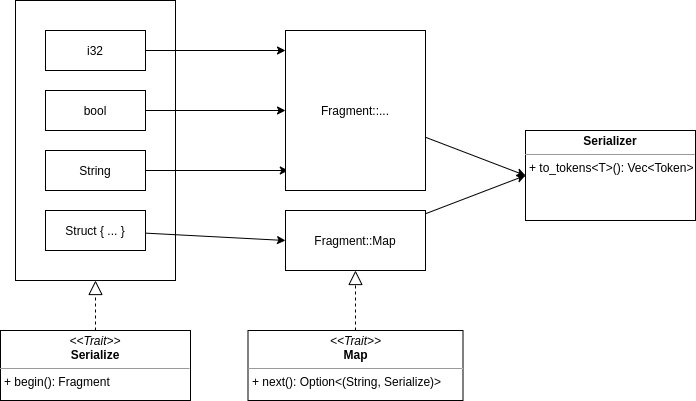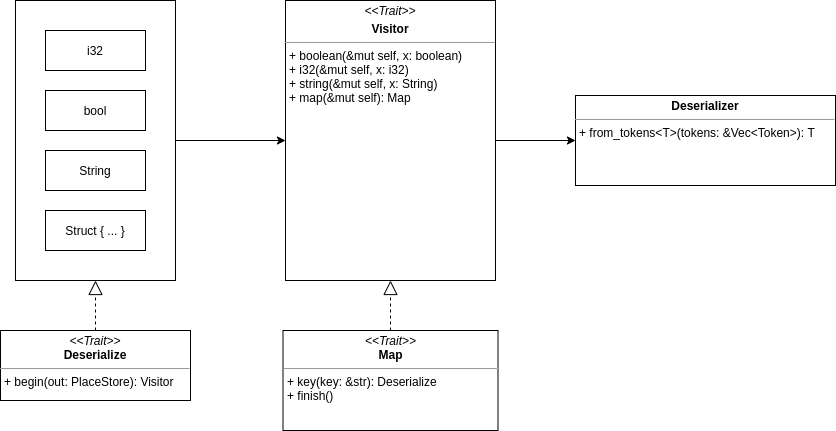从 Rust 库学 - miniminiserde
前言
说来惭愧,搞 Rust 以来一直也只能写一些业务级别的代码,库级别的代码写不来。因此专门开一个新的系列 “从库学 Rust”,希望通过学习实现 Rust 一些库的 Demo 版本来提高对 Rust 的理解与编码水平。
本文实现了一个简化版本的 miniserde,在原本的基础上做出以下简化:
- 重点考虑实现序列化 API 为
to_tokens,反序列化 API 为from_tokens; - 只支持
bool,i32,String与 struct; - 针对 Token,而非字符串;
- 不考虑性能、合法性校验等;
本文源码保存在了 Github。
本文的 TODO:
- 读 serde 源码后加以比较;
Serialize
整体思路

整体上,为类型实现 Serialize trait,使得它们有能力转为 Fragment,不同 Serializer(如 JSON Serializer)基于 Fragment 做序列化结果计算。
Serialize 基础类型
对于基础类型 i32, bool, String,直接将自身的值挂到 Fragment 上。如以下对于 bool 类型的实现。
1 2 3 4 5 6 7 8 9 10pub enum Fragment { Boolean(bool), // ... } impl Serialize for bool { fn begin(&self) -> Result<Fragment> { Ok(Fragment::Boolean(*self)) } }
Serialize struct
对于 struct,实现 通过 Serialize macro,使得可以通过 derive(Serialize) 的方式将自身转为 Fragment::Map(Map),这里的 Map 是一个迭代器,通过 next 方法能够拿到 (String, Serialize) KV 对,对应于结构体每一项的 key 与 value。
具体实现上,Map 记录了:
- 结构体自身的引用;
- 迭代器内部枚举下标;
1 2 3 4 5struct __Map<'a> { // 结构体值自身引用,#ident 是 结构体名 data: &'a #ident, cur: usize }
为 Map 实现 Map trait。由于是写在 macro 里的,直接枚举 key 即可。
1 2 3 4 5 6 7 8 9 10 11 12 13 14impl<'a> ser::Map for __Map<'a> { fn next(&mut self) -> Option<(String, &dyn Serialize)> { match self.cur { #(#indexes => { self.cur += 1; // 枚举结构体 key let key = #field_name_list; let value = &self.data.#field_ident_list; Some((key.to_owned(), value)) },)* _ => None } } }
从这里也可以看出 Map 使用迭代器的好处:外部调用者只需要能够获取 KV 对,并不需要感知内部的具体结构。使用迭代器一来把内部复杂的结构屏蔽了(也许并不复杂= =),二来按需取值,不需要一次性返回,有利于优化内存效率。
to_tokens 实现
到这里 to_tokens 的实现就比较明显了:
- 对于基础类型,直接取值转为
Token; - 对于 struct,遍历迭代器取 key-value,然后对 value 再做递归;
1 2 3 4 5 6 7 8 9 10 11 12 13 14 15 16 17 18 19 20 21 22 23 24 25 26 27 28// UnsafeRcVec<T> 是对 Vec<T> 的封装,使得能够在 Rc 包裹下同时持有 &mut fn to_token_impl(v: &dyn Serialize, mut vec: UnsafeRcVec<Token>) -> Result<()> { let fragment = Serialize::begin(v)?; match fragment { Fragment::I32(x) => { vec.push(Token::I32(x)); } Fragment::Boolean(x) => { vec.push(Token::Boolean(x)); } Fragment::String(x) => { vec.push(Token::String(x)); } Fragment::Map(mut map) => { let mut should_push_comma = false; vec.push(Token::LB); while let Some((key, v)) = map.next() { if should_push_comma { vec.push(Token::Comma); } should_push_comma = true; vec.push(Token::String(key)); vec.push(Token::Colon); to_token_impl(v, vec.clone())?; } vec.push(Token::RB); } } Ok(()) }
Deserialize
整体思路

整体上,为支持类型实现 Deserialize trait,使得不同的 Deserializer 有能力通过统一的 Visitor trait 向属于这一类型的存储变量内部写入反序列化结果。
PlaceStore
PlaceStore 是一个允许同时持有并写入的结构,其是核心是 Rc<Option<T>>,由 Rc 提供同时持有的能力。当有了 PlaceStore 后,就可以赋予 Visitor 能力,此时 PlaceStore 被外围方法和自身(作为 Visitor)同时持有,由 Visitor 在工作流程中写入值,外围函数在工作结束后将值取出。
1 2 3 4 5 6 7 8 9 10 11 12 13 14 15 16 17 18 19pub struct PlaceStore<T> { out: Rc<Option<T>>, } impl<T> PlaceStore<T> { pub fn set(&mut self, value: T) { let inner = unsafe { Rc::get_mut_unchecked(&mut self.out) }; *inner = Some(value); } pub fn try_unwrap(mut self) -> Result<T> { let out = unsafe { Rc::get_mut_unchecked(&mut self.out) }; out.take().ok_or(Error) } pub fn clone(&self) -> Self { Self { out: Rc::clone(&self.out), } } }
Visitor
Visitor trait 代表了向内部写入值的能力,在默认实现中,将所有实现都置为未实现,由实现方做方法实现覆盖。
这里的 Visitor 确实就是设计模式中的 访问者模式,面向了一组不同类型存储对象提供写入自身的能力。
1 2 3 4 5 6 7 8 9 10 11 12 13 14pub trait Visitor { fn boolean(&mut self, _x: bool) -> Result<()> { unimplemented!() } fn i32(&mut self, _x: i32) -> Result<()> { unimplemented!() } fn string(&mut self, _x: &str) -> Result<()> { unimplemented!() } fn map(&mut self) -> Result<Box<dyn Map>> { unimplemented!() } }
make_place!
由于 PlaceStore 后续需要 impl Visitor,但对于外部 crate,引入 PlaceStore 实现 Visitor trait 违背孤儿规则,因此,这里可以编写一个 macro make_place! 把 PlaceStore 包一层。
1 2 3 4 5 6 7 8#[macro_export] macro_rules! make_place { ($name:ident) => { pub struct $name<T> { pub out: PlaceStore<T>, } }; }
这样对于外部 crate,就可以编写代码如:
1 2 3 4 5make_place!(_Place); impl Visitor for _Place { // ... }
同时为了方便本 crate 的使用,写下 make_place!(Place) 以后续对 Place 实现 Visitor trait。
Deserialize 基础类型
这里以 bool 为例。对 bool 实现 Deserialize trait,其内部对 Place<bool> 实现 Visitor trait,在 Visitor trait 中覆盖 boolean 方法,使得此方法调用时可将值写入外部传入的 PlaceStore 中。
1 2 3 4 5 6 7 8 9 10 11 12 13impl Deserialize for bool { fn begin(out: PlaceStore<Self>) -> Box<dyn Visitor> { impl Visitor for Place<bool> { fn boolean(&mut self, x: bool) -> Result<()> { self.out.set(x); Ok(()) } } let place = Place { out }; Box::new(place) } }
Deserialize struct
对于 struct,重点在于对 Map trait 的实现上。
内部构造 __Map,其枚举 struct 的每一个字段,并分别配上一个 PlaceStore。另外,还需要维护自身对应的 PlaceStore。
1 2 3 4struct __Map { #(#field_ident_list: PlaceStore<#field_ty_list>,)* __out: PlaceStore<#ident> }
这样当外部调用 key 方法时,可以通过 key 对应的 PlaceStore 创建对应的 Visitor。
当外部调用 finish 方法时,将各字段对应的 PlaceStore 中的值提取出来并构造自身值,最后写入自身的 PlaceStore 中。
1 2 3 4 5 6 7 8 9 10 11 12 13 14 15 16 17 18 19 20 21 22 23impl de::Map for __Map { fn key(&mut self, key: &str) -> Result<Box<dyn Visitor>> { match key { #(#field_name_list => { let out = self.#field_ident_list.clone(); Ok(Deserialize::begin(out)) },)* _ => { return Err(Error) } } } fn finish(&mut self) -> Result<()> { #( let #field_ident_list = self.#field_ident_list.clone().try_unwrap()?; )* self.__out.set(#ident { #(#field_ident_list),* }); Ok(()) } }
from_tokens 实现
在核心函数 from_tokens_impl 中,假定已经实现了 Deserializer,其 event 方法能够获取接下来的状态:
- 是基础类型时,直接调用
Visitor对应方法写入; - 是 "{",即对象时,调用
vistor.map创建Map,后在遍历中先通过解析 key 得到 value 应当写入的Visitor,再通过递归完成对 value 的写入,直到遇到 "}" 时完成对整个Map的写入; - 无可读 Token,则成功结束;
在外围函数 from_tokens 中,创建对应的 PlaceStore 与 Visitor 以调用 from_tokens_impl,结束后取出 PlaceStore 的值并返回即可。
1 2 3 4 5 6 7 8 9 10 11 12 13 14 15 16 17 18 19 20 21 22 23 24 25 26 27 28 29 30 31 32 33 34 35 36 37 38 39 40 41 42 43 44 45pub fn from_tokens<'a, T: Deserialize>(tokens: &'a Vec<Token>) -> Result<T> { let out: PlaceStore<T> = Default::default(); let mut de = Deserializer::new(tokens); let visitor = T::begin(out.clone()); from_tokens_impl(&mut de, visitor)?; let out = out.try_unwrap()?; Ok(out) } fn from_tokens_impl<'a>(de: &mut Deserializer, mut visitor: Box<dyn Visitor>) -> Result<()> { match de.event()? { Event::Primitive(token) => match token { Token::I32(x) => { visitor.i32(x)?; } // ... }, // Token::LB ({) Event::MapStart => { let mut map = visitor.map()?; 'map_start_loop: loop { let key = match de.parse() { Token::String(x) => Ok(x), Token::RB => break 'map_start_loop, _ => Err(Error), }?; de.parse(); // : let visitor = map.key(&key)?; from_tokens_impl(de, visitor)?; if let Token::Comma = de.peek() { de.parse(); // , } if let Token::RB = de.peek() { map.finish()?; } } } Event::End => return Ok(()), }; Ok(()) }
其他知识点
Cow
Cow 是 clone-on-write 的智能指针,
- 当使用
Cow::from(&...),或使用Cow::Borrowed(&...)时,只会与被借用方共享数据; - 当使用
(...).to_mut()时若当前没有数据的所有权,则会 clone 一份被借用方的数据,若已持有则不会 clone;
在 读多写少 的场景下,使用 Cow 能够提高性能。miniserde 在 Serialize String 时使用了 Cow:
1 2 3 4 5impl Serialize for String { fn begin(&self) -> Fragment { Fragment::Str(Cow::Borrowed(self)) } }
String 与 &str 的 Deref coercion
由于 String 内部实现了
1 2 3 4impl ops::Deref for String { type Target = str; // ... }
因此将 &String 类型传递给 &str 类型时,编译器会做隐式强制转换。下列代码是合法且常用的:
1 2 3 4 5 6 7 8 9fn fetch(url: &str) { // ... } fn main() { // 从某处获取的 url let url = format!("https://{}/about", "www.google.com"); // Okay, 将 &String 传递给 &str fetch(&url); }
扩展生命周期
core::mem::transmute 用于自行解释字节,如:
1 2 3 4 5 6 7fn main() { let v: [i8; 4] = [0x12, 0x34, 0x56, 0x78]; // [i8; 4] 与 i32 都是 4 字节 let x: i32 = unsafe { core::mem::transmute(v) }; assert_eq!(x, 0x78563412); }
在 miniserde 中,定义 extend_lifetime!(EXPR as TYPE) 宏展开为 std::mem::transmute::<TYPE, TYPE>(EXPR) 以扩展生命周期,如:
1 2 3 4 5 6fn map(&mut self) -> Result<Box<dyn Map + '_>> { let mut value = NonuniqueBox::new(None); // ptr 被推导为 &mut Option<T> let ptr = unsafe { extend_lifetime!(&mut *value as &mut Option<T>) }; // ... }
自定义的 NonuniqueBox
Box 定义为:
1pub struct Box<T: ?Sized, A: Allocator = Global>(Unique<T>, A);
其中 Unique 是类似于 NonNull 对 raw pointer 的封装。不同于 NonNull,持有 Unique<T> 则被认为独自占有 pointer 所指向的数据,这也是 Unique 名字的由来。
Box, Unique 的定义如下:
1 2 3 4 5 6 7 8 9 10 11 12 13pub struct NonNull<T: ?Sized> { pointer: *const T, } pub struct Unique<T: ?Sized> { pointer: *const T, // NOTE: this marker has no consequences for variance, but is necessary // for dropck to understand that we logically own a `T`. // // For details, see: // https://github.com/rust-lang/rfcs/blob/master/text/0769-sound-generic-drop.md#phantom-data _marker: PhantomData<T>, }
可以看出 Unique 多了一个属性 _marker: PhantomData<T>,PhantomData<T> 的存在让编译器知晓这一数据类型逻辑上拥有 T,而不是仅仅拥有一个指向 T 类型的指针,这使得:
- std 中为
Unique实现了Sync,Send; - Drop 检查器(dropck, drop checker)在某些情况下会做 drop 检查;
miniserde 中定义了 NonuniqueBox,对比于 Box,其包含的是 NonNull 而不是 Unique。从语义上,这使得可以将 &mut 引用转移到其他地方,通过这一引用写入数据,最后再 drop 这个 NonuniqueBox。(实际上,笔者将 NonuniqueBox 换成 Box 后依然可以编译通过并通过原有的测试。)
1 2 3 4 5 6 7 8 9 10 11 12 13 14 15 16 17 18 19 20 21 22 23 24 25 26// 原本代码的注释: // Like Box<T>, but holds NonNull<T> instead of Unique<T> to defer asserting // uniqueness throughout the lifetime of the object until Drop is called. This // makes it possible to take a &mut reference to the heap allocation, then move // the NonuniqueBox, then write to the heap allocation through that old // reference, then drop the NonuniqueBox. pub struct NonuniqueBox<T: ?Sized> { ptr: NonNull<T>, } // ... // 暴露 &mut impl<T: ?Sized> DerefMut for NonuniqueBox<T> { fn deref_mut(&mut self) -> &mut Self::Target { unsafe { self.ptr.as_mut() } } } // NonuniqueBox drop 时,销毁 ptr impl<T: ?Sized> Drop for NonuniqueBox<T> { fn drop(&mut self) { let ptr = self.ptr.as_ptr(); let _ = unsafe { Box::from_raw(ptr) }; } }
如 miniserde 在反序列化序列时使用了 NonuniqueBox。
1 2 3 4 5 6 7 8 9 10 11// ... Layer::Seq(mut seq) => { // 取得 &mut 并转为 &mut dyn Visitor let element = seq.element()?; let next = NonNull::from(element); // 后续使用此 Visitor 写入 visitor = unsafe { extend_lifetime!(next as NonNull<dyn Visitor>) }; // 原 NonuniqueBox 保存,后续可能会再次使用 // 当其销毁时,对应的 Visitor 也会被销毁 de.stack.push((outer, Layer::Seq(seq))); }
ManualDrop
ManualDrop 可以包裹变量,用于告知编译器不要 drop 掉这个变量,其将手动调用 drop。在同一结构体中若有多个变量需要手动控制 drop 顺序,可以使用时ManualDrop。
在 miniserde 中,BoxSeq 在 Deserialize Box<Seq<T>> 时使用,其中 value 是存储值,seq 可能持有 value 用于写入数据。因此 drop 时需要先 drop seq,再 drop value。实现中将 seq 用 ManuallyDrop 包裹一层。0
Rust drop 时,会先调用 <T as std::ops::Drop>::drop,再按一定规则 drop 变量。因此可以在 BoxSeq 的 Drop 中手动调用 ManuallyDrop::drop 把 seq drop 掉。
1 2 3 4 5 6 7 8 9 10 11 12 13struct BoxSeq<'a, T: 'a> { out: &'a mut Option<Box<T>>, value: NonuniqueBox<Option<T>>, // 源代码注释: // May borrow from self.value, so must drop first. seq: ManuallyDrop<Box<dyn Seq + 'a>>, } impl<'a, T: 'a> Drop for BoxSeq<'a, T> { fn drop(&mut self) { unsafe { ManuallyDrop::drop(&mut self.seq) } } }